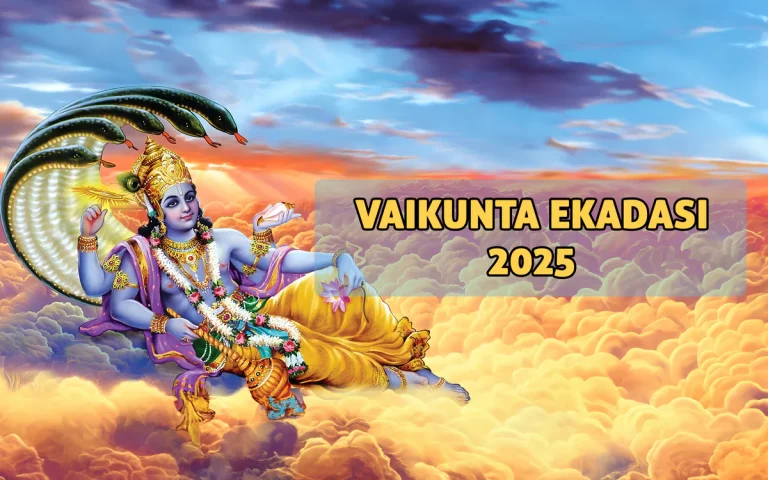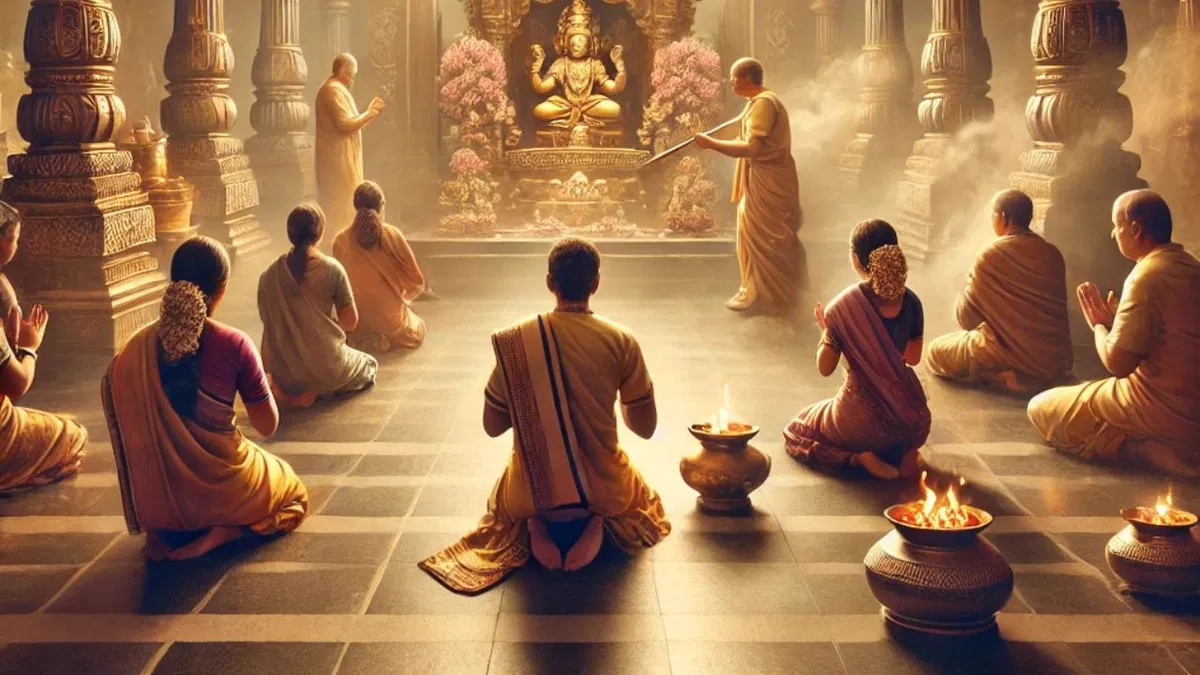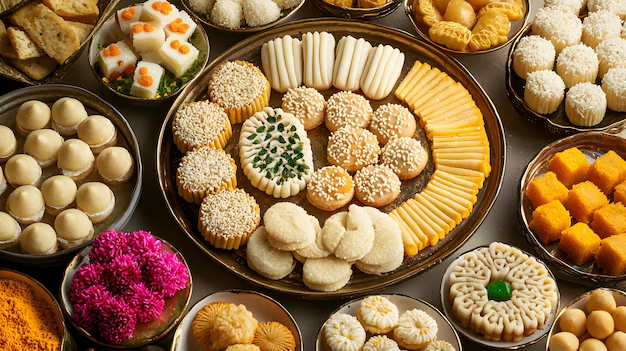- General
- Updated on October 27, 2025
Vaikuthi Chaudas 2025: Date, Rituals, and the Meaning Behind the Celebration

Introduction
Vaikuthi Chaudas — more correctly known as Vaikuntha Chaturdashi — is a unique and spiritually rich festival observed in parts of India. It combines devotion to both Lord Vishnu and Lord Shiva in one meaningful ritual day. For 2025, it carries its own significance, timing, and traditional customs. Let’s dive into what Vaikuntha Chaturdashi is all about: its date, the rituals people follow, the mythology behind it, and how it’s celebrated today.
When Is Vaikuntha Chaturdashi 2025?

- In 2025, Vaikuntha Chaturdashi falls on 4 November.
- The Tithi (Chaturdashi of the waxing moon phase — Shukla Paksha in the month of Kartik) begins early that day, and the observances stretch through the day.
- The Nishita muhurta (midnight / late-night auspicious time) for Vishnu worship is at approximately 11:24 PM to 12:16 AM (crossing into early November 5, depending on local panchang).
Because many temples and devotees use local panchang (calendar) settings, small timing variations may apply by city or region.
What Is the Meaning & Significance of Vaikuntha Chaturdashi
Vaikuntha Chaturdashi holds a special place in Hindu spiritual calendars because:
- Dual Devotion to Vishnu & Shiva
- Unlike many festivals that focus on one deity, this day honors both Lord Vishnu and Lord Shiva together.
- It symbolizes unity between these two major streams of Hindu worship — Vaishnavism and Shaivism.
- Mythological Background
- One popular legend is that Lord Vishnu visited Varanasi (Kashi) to worship Shiva. As part of his devotion, he offered one thousand lotus flowers.
- According to the story, when the 1000th lotus flower could not be found (or went missing), Vishnu gave one of his own lotuses (or in some retellings, one of his eyes, since his eyes are likened to lotuses) to complete the count. Pleased by the sincerity, Lord Shiva restored what was given, and the festival commemorates this act of supreme devotion.
- In some versions, it is also linked with Lord Shiva gifting the Sudarshana Chakra (Vishnu’s divine discus) to Vishnu.
- Spiritual Goal: Cleansing / Liberation (Moksha) & Devotion
- Because of the dual worship and symbolism, observing Vaikuntha Chaturdashi is believed to help devotees cleanse negative karma, strengthen their devotion, and move closer to spiritual liberation (moksha).
- There is also emphasis on ritual purity (bathing, fasting, correct timing) to harness the spiritual potency of the tithi.
- Connection with Kartik Month & Festivals
- It falls in Kartik month — a highly sacred lunar month in many Hindu traditions.
- The day is just before Kartik Purnima (the full‐moon in Kartik) which is itself an auspicious festival day in many regions.
Rituals & Traditions Observed on Vaikuntha Chaturdashi
Here’s how people traditionally honor Vaikuntha Chaturdashi:
| Ritual Name | What Happens | Why It’s Important |
|---|---|---|
| Bath / Sacred Bathing | Devotees take a holy bath early in the day (or at designated times before puja). | Purifies the body and mind; prepares the devotee for worship with spiritual cleanliness. |
| Fasting / Vrat | Many keep a fast — partially or fully — on the day. | Fasting is a traditional way to show devotion and focus more on spiritual practice rather than physical indulgence. |
| Midnight Puja (Nishita Muhurat) | Worship of Lord Vishnu is especially recommended around midnight (Nishita). | This timing is believed to be spiritually powerful; special prayers or offerings are made then. |
| Dawn Puja (Arunodaya Muhurat) | For devotees of Lord Shiva, worship at dawn or shortly before sunrise is important. | Early morning worship connects with natural purity, light, and renewal. |
| Offerings Like Lotus Flowers | One of the central symbolic offerings is the lotus (or thousand lotus motif) to the deity during puja. | Represents purity, devotion, and connects to the mythological story. |
| Chanting / Mantras | Recitation of sacred names or hymns — e.g. Vishnu Sahasranama — is part of many ritual practices. | Mantras focus devotion, help concentration, and are believed to amplify blessings through the sound vibration. |
| Special Puja Sequence & Preparation | Worship may include abhishek (ritual bathing of deity idols), use of lamps (diyas), incense, traditional bhog offerings (e.g. kheer made from corn flour in some regions). | These traditional items are part of the ritual heritage, adding texture and cultural meaning to the prayers. |
Besides home puja, many temples conduct special ceremonies — especially in Varanasi (Kashi Vishwanath Temple), and in other regions where this festival is celebrated strongly.
Regional Observance & Modern Practices
- Varanasi / Kashi
The festival has strong roots in Varanasi, where Lord Shiva (as Kashi Vishwanath) is worshipped in a special way. On Vaikuntha Chaturdashi, some traditions say the temple takes on extra spiritual significance.
Devotees may perform snan (ritual bath) at sacred ghats near river Ganges in early hours. - Other Regional Celebrations
You’ll find observance in parts of North India, especially where both Shiva and Vishnu traditions are strong together.
Local temples may organize special pujas, community gatherings, and cultural events that highlight mythology, bhajans (devotional songs), and spiritual discourse. - In Modern Times
Some devotees and temples use digital or community-shared platforms to spread awareness of festival timings, share mantras, and organize collective pujas. Social media or temple websites may publish live timings or livestreams. - Many modern households incorporate the traditional rituals (fasting, chanting, lamp lighting) along with convenience — preparing offerings ahead, inviting family members, or combining with charitable giving aligned with the spirit of devotion and purification.
How You Can Observe Vaikuntha Chaturdashi at Home (A Practical Guide)
If you want to observe Vaikuntha Chaturdashi in your family or home, here are some steps to follow:
- Check Your Local Panchang
- Tithi start and end times vary by location (city, timezone).
- Confirm Nishita Muhurat and Arunodaya Muhurat in your city.
- Prepare the Puja Items
- Fresh lotus or flowers (if you can get lotuses)
- Incense, diyas / lamps, ghee or cow-ghee mixes (some add saffron / kesar)
- Offerings like kheer (or whatever traditional sweet is used in your region), water / milk / curd offerings for abhishek, incense sticks, new clothes.
- Fast or Observe Vrat
- Decide whether you will fast (some may take water / fruit only) or partially abstain from food before puja.
- Wake up early, take bath before the puja time.
- Perform Puja at Designated Times
- At midnight (Nishita) perform rituals honoring Lord Vishnu.
- At dawn (Arunodaya) perform Shiva-related worship.
- Recite appropriate mantras or hymns. If you have Vishnu Sahasranama, bhajans, or songs relevant to Shiva, include them.
- Reflect & Set Intention
- As you perform the rituals, reflect on what purification or devotion means for you personally.
- Maybe use the day to let go of emotional burdens (anger, guilt), resolve to deepen your spiritual practice, or extend kindness (charity or helping others) in the spirit of devotion.
- Share With Family or Community
- Some of the beauty lies in shared observance. Invite family or friends.
- If possible, visit a temple that observes special puja on this day.
Also Read: The Significance of Chhath Puja in Hindu Culture
Closing Thoughts
Vaikuntha Chaturdashi (Vaikuthi Chaudas) may not be as widely known as some festivals like Diwali or Navratri — but its blend of myth, deep devotion, and symbolic worship makes it profoundly meaningful.
In 2025, the date falls on 4 November, and it offers devotees a rare chance to unite reverence for both Vishnu and Shiva, harness powerful ritual timings (midnight & dawn), cleanse the spirit, and renew spiritual purpose.
Whether you observe it at home or attend temple ceremonies, doing the puja with sincerity, mindfulness, and attention to traditional timings enhances both your connection with heritage and your inner peace.
Join the discussion
Related Articles
No results available
ResetTrending Articles


- General
- Updated on October 27, 2025


- General
- Updated on October 27, 2025

- General
- Updated on October 23, 2025


- General
- Updated on October 22, 2025


- General
- Updated on October 18, 2025


- General
- Updated on October 17, 2025


- General
- Updated on October 15, 2025


- General
- Updated on October 15, 2025


- General
- Updated on October 9, 2025


- Fashion
- Updated on October 7, 2025
No results available
Reset

